Electric Vehicles: Sustainable Development and Environmental Benefits
VerifiedAdded on 2022/11/17
|10
|2553
|336
Essay
AI Summary
This essay explores the electric car as a significant advancement in the automotive industry, examining its benefits, drawbacks, and overall impact on environmental sustainability. The essay highlights the advantages of electric cars, such as zero tailpipe emissions, energy efficiency, and reduced greenhouse gas emissions, while also addressing the disadvantages, including limited driving range and longer recharge times. The essay delves into how electric cars contribute to a better environment by reducing carbon emissions and promoting energy independence through renewable energy sources. It also discusses the economic incentives and performance advantages of electric vehicles, such as lower maintenance costs and improved acceleration. The essay references several studies to support its arguments and concludes that, despite some drawbacks, electric cars offer a promising path toward a sustainable future by minimizing environmental impact and promoting greener technologies. The essay also provides insights into the role of government incentives and technological advancements in accelerating the adoption of electric vehicles, making it a comprehensive analysis of the topic.

ENVIRONMENTAL MANAGEMENT FOR SUSTAINABLE DEVELOPMENT
By Name
Course
Instructor
Institution
Location
Date
By Name
Course
Instructor
Institution
Location
Date
Paraphrase This Document
Need a fresh take? Get an instant paraphrase of this document with our AI Paraphraser
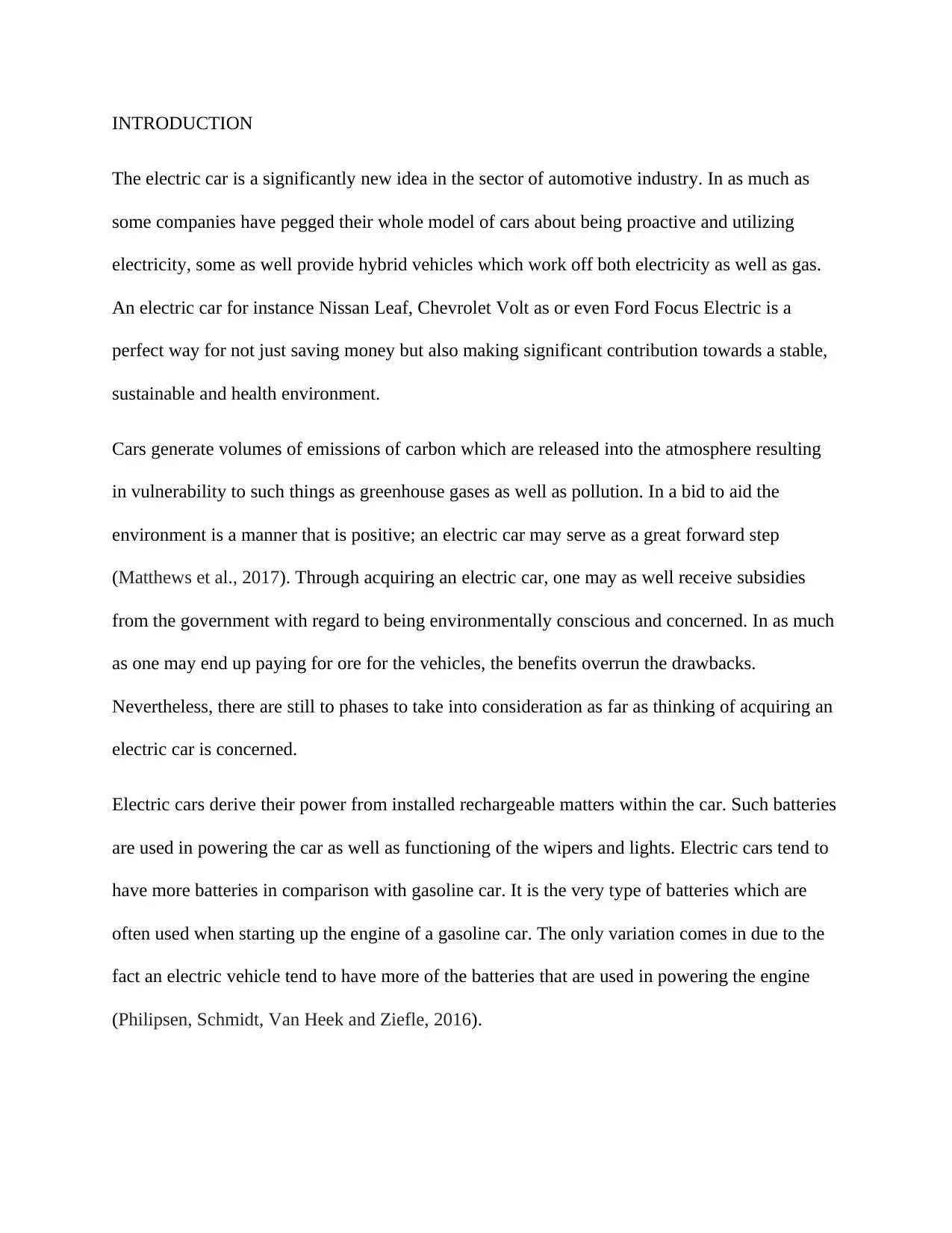
INTRODUCTION
The electric car is a significantly new idea in the sector of automotive industry. In as much as
some companies have pegged their whole model of cars about being proactive and utilizing
electricity, some as well provide hybrid vehicles which work off both electricity as well as gas.
An electric car for instance Nissan Leaf, Chevrolet Volt as or even Ford Focus Electric is a
perfect way for not just saving money but also making significant contribution towards a stable,
sustainable and health environment.
Cars generate volumes of emissions of carbon which are released into the atmosphere resulting
in vulnerability to such things as greenhouse gases as well as pollution. In a bid to aid the
environment is a manner that is positive; an electric car may serve as a great forward step
(Matthews et al., 2017). Through acquiring an electric car, one may as well receive subsidies
from the government with regard to being environmentally conscious and concerned. In as much
as one may end up paying for ore for the vehicles, the benefits overrun the drawbacks.
Nevertheless, there are still to phases to take into consideration as far as thinking of acquiring an
electric car is concerned.
Electric cars derive their power from installed rechargeable matters within the car. Such batteries
are used in powering the car as well as functioning of the wipers and lights. Electric cars tend to
have more batteries in comparison with gasoline car. It is the very type of batteries which are
often used when starting up the engine of a gasoline car. The only variation comes in due to the
fact an electric vehicle tend to have more of the batteries that are used in powering the engine
(Philipsen, Schmidt, Van Heek and Ziefle, 2016).
The electric car is a significantly new idea in the sector of automotive industry. In as much as
some companies have pegged their whole model of cars about being proactive and utilizing
electricity, some as well provide hybrid vehicles which work off both electricity as well as gas.
An electric car for instance Nissan Leaf, Chevrolet Volt as or even Ford Focus Electric is a
perfect way for not just saving money but also making significant contribution towards a stable,
sustainable and health environment.
Cars generate volumes of emissions of carbon which are released into the atmosphere resulting
in vulnerability to such things as greenhouse gases as well as pollution. In a bid to aid the
environment is a manner that is positive; an electric car may serve as a great forward step
(Matthews et al., 2017). Through acquiring an electric car, one may as well receive subsidies
from the government with regard to being environmentally conscious and concerned. In as much
as one may end up paying for ore for the vehicles, the benefits overrun the drawbacks.
Nevertheless, there are still to phases to take into consideration as far as thinking of acquiring an
electric car is concerned.
Electric cars derive their power from installed rechargeable matters within the car. Such batteries
are used in powering the car as well as functioning of the wipers and lights. Electric cars tend to
have more batteries in comparison with gasoline car. It is the very type of batteries which are
often used when starting up the engine of a gasoline car. The only variation comes in due to the
fact an electric vehicle tend to have more of the batteries that are used in powering the engine
(Philipsen, Schmidt, Van Heek and Ziefle, 2016).

BENEFITS AN ELECTRIC CAR
No gas needed: Electric cars are wholly charged using electricity that is provided hence one
does not need to acquire gasoline any more. The car which is based on driving fuel may burn a
hole in the pocket of the owner since the fuel prices have continued to be on the rise every time.
Such cost may be avoided with the electric cars as an average American uses between $2000 and
$4000 on acquiring gasoline every year. In as much as the electricity used in recharging is not
free, the electric car tends to be far much cheaper to operate.
Savings: Electric cars may be fuelled for very low prices and numerous new cars would provide
great incentives for one to get back the money for the government for championing for going
green. Electric cars may as well save money in the life of an individual.
Better to the environment: Electric cars do not have tailpipe emissions and if anything do not
have an exhaust. They have relatively lower mean emissions in comparison with the
conventional diesel or petrol and this may aid in enhancing the quality of air specifically in the
urban regions as well as at the sides of the roads in which the quality of air may be very poor.
Even with regard to the effects of producing the electricity used electric vehicles may still
generate significantly lower greenhouse gases as compared with diesel or petrol cars (Halbey,
Kowalewski and Ziefle, 2015). Such emissions would be lowered furthered as a country shifts to
more renewable as well as nuclear electricity production. Throughout their entire life cycle,
electric cars tend to have lower greenhouse emisions as compared with internal combustion
engine vehicles. The manufacture of the battery may be the offset through enhanced efficiency as
well as emissions saving over the car life.
No gas needed: Electric cars are wholly charged using electricity that is provided hence one
does not need to acquire gasoline any more. The car which is based on driving fuel may burn a
hole in the pocket of the owner since the fuel prices have continued to be on the rise every time.
Such cost may be avoided with the electric cars as an average American uses between $2000 and
$4000 on acquiring gasoline every year. In as much as the electricity used in recharging is not
free, the electric car tends to be far much cheaper to operate.
Savings: Electric cars may be fuelled for very low prices and numerous new cars would provide
great incentives for one to get back the money for the government for championing for going
green. Electric cars may as well save money in the life of an individual.
Better to the environment: Electric cars do not have tailpipe emissions and if anything do not
have an exhaust. They have relatively lower mean emissions in comparison with the
conventional diesel or petrol and this may aid in enhancing the quality of air specifically in the
urban regions as well as at the sides of the roads in which the quality of air may be very poor.
Even with regard to the effects of producing the electricity used electric vehicles may still
generate significantly lower greenhouse gases as compared with diesel or petrol cars (Halbey,
Kowalewski and Ziefle, 2015). Such emissions would be lowered furthered as a country shifts to
more renewable as well as nuclear electricity production. Throughout their entire life cycle,
electric cars tend to have lower greenhouse emisions as compared with internal combustion
engine vehicles. The manufacture of the battery may be the offset through enhanced efficiency as
well as emissions saving over the car life.
⊘ This is a preview!⊘
Do you want full access?
Subscribe today to unlock all pages.

Trusted by 1+ million students worldwide
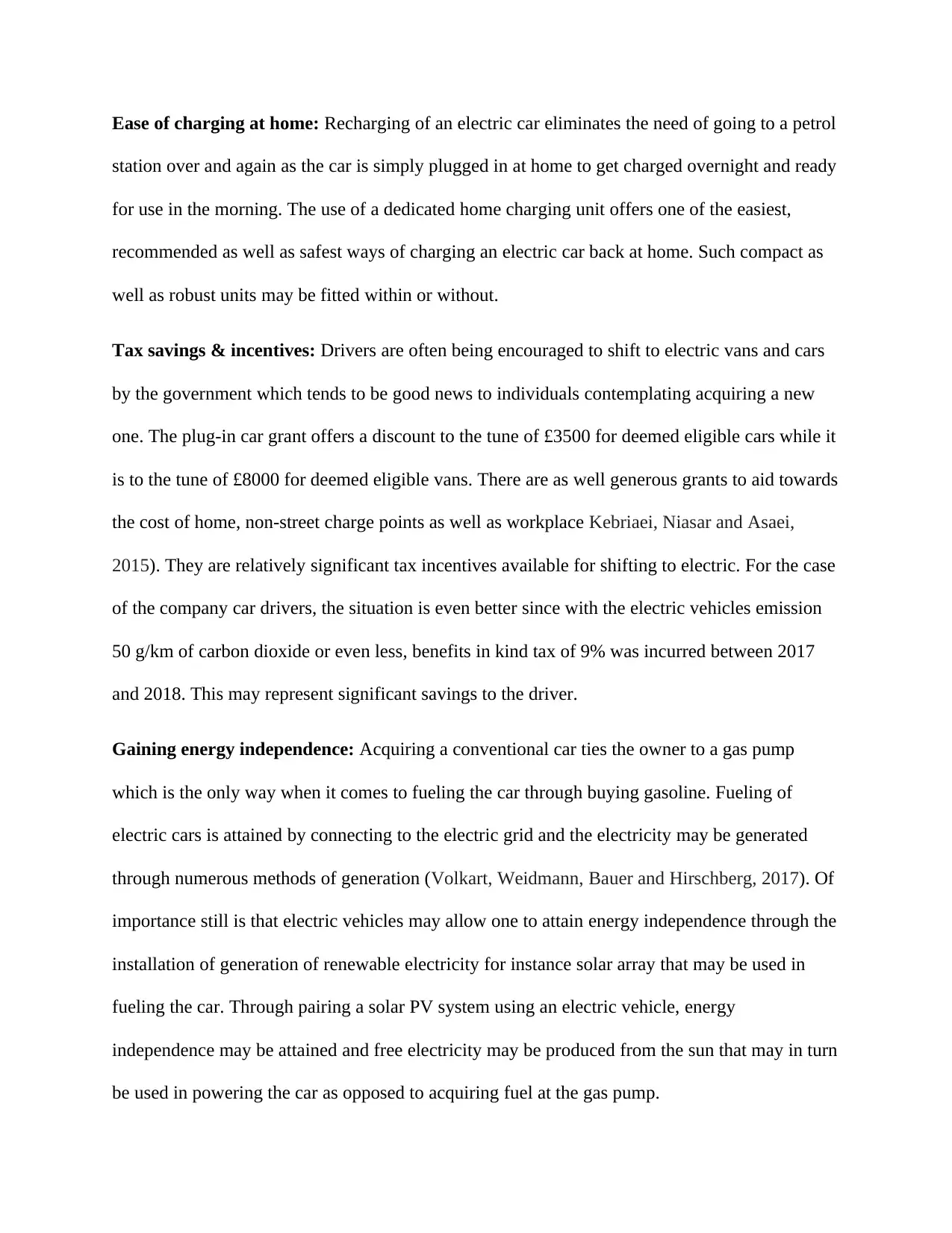
Ease of charging at home: Recharging of an electric car eliminates the need of going to a petrol
station over and again as the car is simply plugged in at home to get charged overnight and ready
for use in the morning. The use of a dedicated home charging unit offers one of the easiest,
recommended as well as safest ways of charging an electric car back at home. Such compact as
well as robust units may be fitted within or without.
Tax savings & incentives: Drivers are often being encouraged to shift to electric vans and cars
by the government which tends to be good news to individuals contemplating acquiring a new
one. The plug-in car grant offers a discount to the tune of £3500 for deemed eligible cars while it
is to the tune of £8000 for deemed eligible vans. There are as well generous grants to aid towards
the cost of home, non-street charge points as well as workplace Kebriaei, Niasar and Asaei,
2015). They are relatively significant tax incentives available for shifting to electric. For the case
of the company car drivers, the situation is even better since with the electric vehicles emission
50 g/km of carbon dioxide or even less, benefits in kind tax of 9% was incurred between 2017
and 2018. This may represent significant savings to the driver.
Gaining energy independence: Acquiring a conventional car ties the owner to a gas pump
which is the only way when it comes to fueling the car through buying gasoline. Fueling of
electric cars is attained by connecting to the electric grid and the electricity may be generated
through numerous methods of generation (Volkart, Weidmann, Bauer and Hirschberg, 2017). Of
importance still is that electric vehicles may allow one to attain energy independence through the
installation of generation of renewable electricity for instance solar array that may be used in
fueling the car. Through pairing a solar PV system using an electric vehicle, energy
independence may be attained and free electricity may be produced from the sun that may in turn
be used in powering the car as opposed to acquiring fuel at the gas pump.
station over and again as the car is simply plugged in at home to get charged overnight and ready
for use in the morning. The use of a dedicated home charging unit offers one of the easiest,
recommended as well as safest ways of charging an electric car back at home. Such compact as
well as robust units may be fitted within or without.
Tax savings & incentives: Drivers are often being encouraged to shift to electric vans and cars
by the government which tends to be good news to individuals contemplating acquiring a new
one. The plug-in car grant offers a discount to the tune of £3500 for deemed eligible cars while it
is to the tune of £8000 for deemed eligible vans. There are as well generous grants to aid towards
the cost of home, non-street charge points as well as workplace Kebriaei, Niasar and Asaei,
2015). They are relatively significant tax incentives available for shifting to electric. For the case
of the company car drivers, the situation is even better since with the electric vehicles emission
50 g/km of carbon dioxide or even less, benefits in kind tax of 9% was incurred between 2017
and 2018. This may represent significant savings to the driver.
Gaining energy independence: Acquiring a conventional car ties the owner to a gas pump
which is the only way when it comes to fueling the car through buying gasoline. Fueling of
electric cars is attained by connecting to the electric grid and the electricity may be generated
through numerous methods of generation (Volkart, Weidmann, Bauer and Hirschberg, 2017). Of
importance still is that electric vehicles may allow one to attain energy independence through the
installation of generation of renewable electricity for instance solar array that may be used in
fueling the car. Through pairing a solar PV system using an electric vehicle, energy
independence may be attained and free electricity may be produced from the sun that may in turn
be used in powering the car as opposed to acquiring fuel at the gas pump.
Paraphrase This Document
Need a fresh take? Get an instant paraphrase of this document with our AI Paraphraser
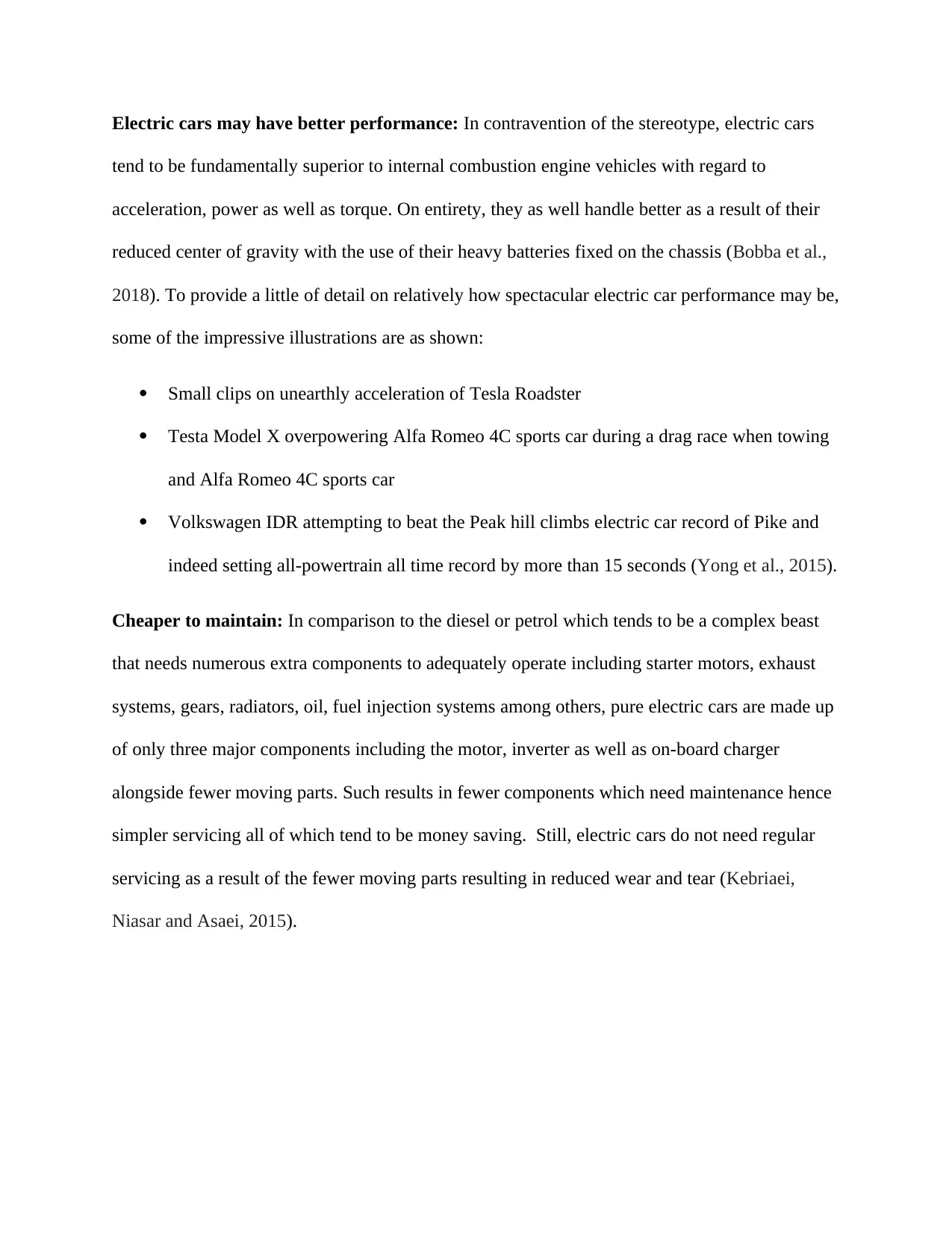
Electric cars may have better performance: In contravention of the stereotype, electric cars
tend to be fundamentally superior to internal combustion engine vehicles with regard to
acceleration, power as well as torque. On entirety, they as well handle better as a result of their
reduced center of gravity with the use of their heavy batteries fixed on the chassis (Bobba et al.,
2018). To provide a little of detail on relatively how spectacular electric car performance may be,
some of the impressive illustrations are as shown:
Small clips on unearthly acceleration of Tesla Roadster
Testa Model X overpowering Alfa Romeo 4C sports car during a drag race when towing
and Alfa Romeo 4C sports car
Volkswagen IDR attempting to beat the Peak hill climbs electric car record of Pike and
indeed setting all-powertrain all time record by more than 15 seconds (Yong et al., 2015).
Cheaper to maintain: In comparison to the diesel or petrol which tends to be a complex beast
that needs numerous extra components to adequately operate including starter motors, exhaust
systems, gears, radiators, oil, fuel injection systems among others, pure electric cars are made up
of only three major components including the motor, inverter as well as on-board charger
alongside fewer moving parts. Such results in fewer components which need maintenance hence
simpler servicing all of which tend to be money saving. Still, electric cars do not need regular
servicing as a result of the fewer moving parts resulting in reduced wear and tear (Kebriaei,
Niasar and Asaei, 2015).
tend to be fundamentally superior to internal combustion engine vehicles with regard to
acceleration, power as well as torque. On entirety, they as well handle better as a result of their
reduced center of gravity with the use of their heavy batteries fixed on the chassis (Bobba et al.,
2018). To provide a little of detail on relatively how spectacular electric car performance may be,
some of the impressive illustrations are as shown:
Small clips on unearthly acceleration of Tesla Roadster
Testa Model X overpowering Alfa Romeo 4C sports car during a drag race when towing
and Alfa Romeo 4C sports car
Volkswagen IDR attempting to beat the Peak hill climbs electric car record of Pike and
indeed setting all-powertrain all time record by more than 15 seconds (Yong et al., 2015).
Cheaper to maintain: In comparison to the diesel or petrol which tends to be a complex beast
that needs numerous extra components to adequately operate including starter motors, exhaust
systems, gears, radiators, oil, fuel injection systems among others, pure electric cars are made up
of only three major components including the motor, inverter as well as on-board charger
alongside fewer moving parts. Such results in fewer components which need maintenance hence
simpler servicing all of which tend to be money saving. Still, electric cars do not need regular
servicing as a result of the fewer moving parts resulting in reduced wear and tear (Kebriaei,
Niasar and Asaei, 2015).

DISADVANTAGES OF ELECTRIC CARS
In as much as proof of positives has been vividly illustrated, there are as well some drawbacks
that every person needs to take into account prior to making a decision on acquisition of electric
car as the next big investment. Such include:
Short range of driving and speed: Electric cars tend to have a limited range as well as speed
with most of such cars bearing a range of between 50 miles and 100 miles and thereafter call for
another recharge. They cannot be used for long journeys in the current state of manufacture and
design in as much as this is anticipated to be improved in the future (Lemme, Arruda and
Bahiense, 2019).
Longer time of recharge: In as much as it takes just a few minutes to accomplish refuelling of
gasoline powered car, to the tune of 8 hours is needed to get an electric car fully powered.
Hence, there is need for dedicated power stations since the recharge time need tends to be quite
long.
Cost of electricity: Failure to carefully consider the options may tend electric cars a hassle on
one’s individual bills. Failing to conduct a thorough and elaborate research on the electric car
one intends to acquire would land him into going for an unwise investment choice. At times, the
electric cars may need a big charge to attain proper functionality which would be a poor
reflection on the electricity bill every month (Heinberg and Fridley, 2016).
In as much as proof of positives has been vividly illustrated, there are as well some drawbacks
that every person needs to take into account prior to making a decision on acquisition of electric
car as the next big investment. Such include:
Short range of driving and speed: Electric cars tend to have a limited range as well as speed
with most of such cars bearing a range of between 50 miles and 100 miles and thereafter call for
another recharge. They cannot be used for long journeys in the current state of manufacture and
design in as much as this is anticipated to be improved in the future (Lemme, Arruda and
Bahiense, 2019).
Longer time of recharge: In as much as it takes just a few minutes to accomplish refuelling of
gasoline powered car, to the tune of 8 hours is needed to get an electric car fully powered.
Hence, there is need for dedicated power stations since the recharge time need tends to be quite
long.
Cost of electricity: Failure to carefully consider the options may tend electric cars a hassle on
one’s individual bills. Failing to conduct a thorough and elaborate research on the electric car
one intends to acquire would land him into going for an unwise investment choice. At times, the
electric cars may need a big charge to attain proper functionality which would be a poor
reflection on the electricity bill every month (Heinberg and Fridley, 2016).
⊘ This is a preview!⊘
Do you want full access?
Subscribe today to unlock all pages.

Trusted by 1+ million students worldwide
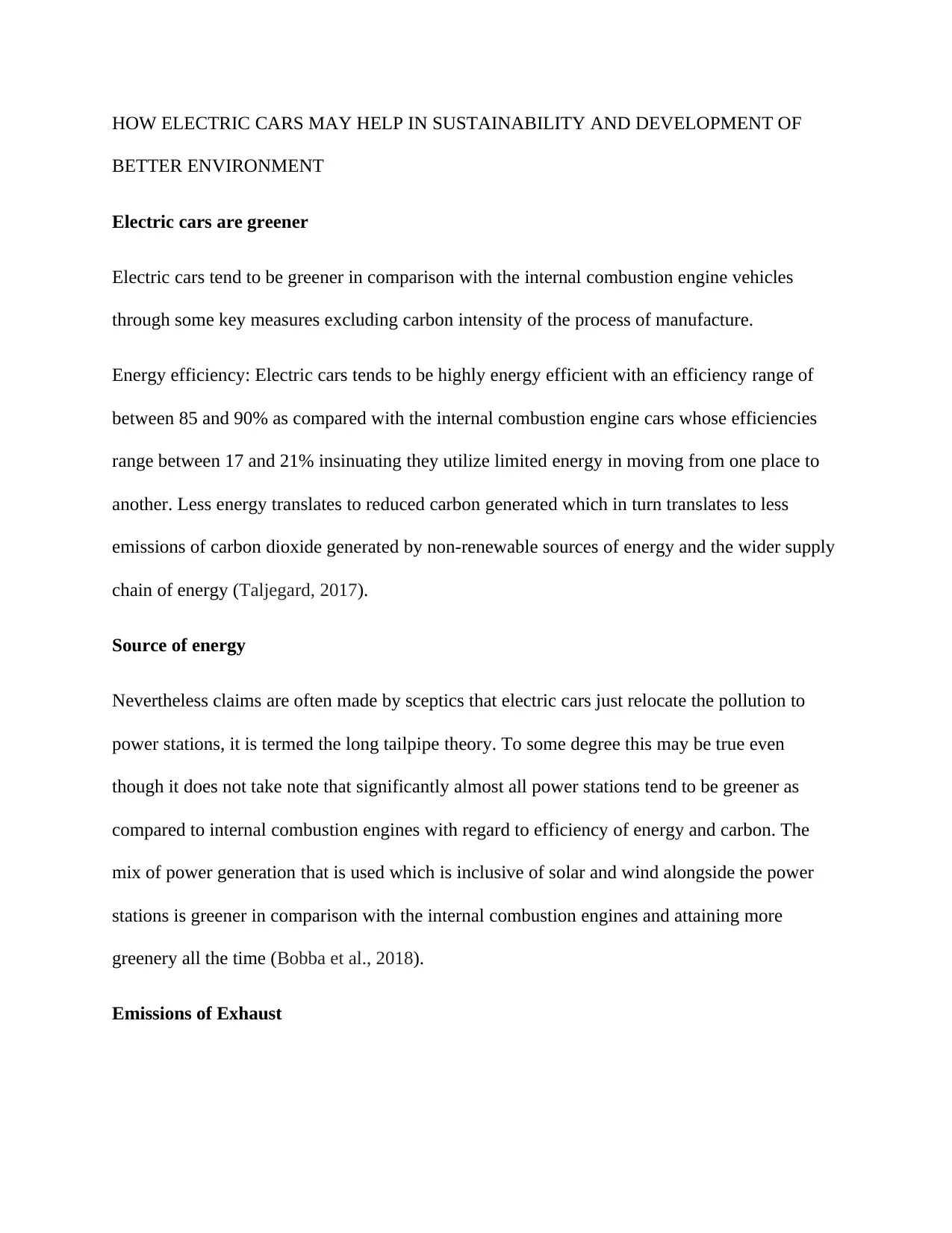
HOW ELECTRIC CARS MAY HELP IN SUSTAINABILITY AND DEVELOPMENT OF
BETTER ENVIRONMENT
Electric cars are greener
Electric cars tend to be greener in comparison with the internal combustion engine vehicles
through some key measures excluding carbon intensity of the process of manufacture.
Energy efficiency: Electric cars tends to be highly energy efficient with an efficiency range of
between 85 and 90% as compared with the internal combustion engine cars whose efficiencies
range between 17 and 21% insinuating they utilize limited energy in moving from one place to
another. Less energy translates to reduced carbon generated which in turn translates to less
emissions of carbon dioxide generated by non-renewable sources of energy and the wider supply
chain of energy (Taljegard, 2017).
Source of energy
Nevertheless claims are often made by sceptics that electric cars just relocate the pollution to
power stations, it is termed the long tailpipe theory. To some degree this may be true even
though it does not take note that significantly almost all power stations tend to be greener as
compared to internal combustion engines with regard to efficiency of energy and carbon. The
mix of power generation that is used which is inclusive of solar and wind alongside the power
stations is greener in comparison with the internal combustion engines and attaining more
greenery all the time (Bobba et al., 2018).
Emissions of Exhaust
BETTER ENVIRONMENT
Electric cars are greener
Electric cars tend to be greener in comparison with the internal combustion engine vehicles
through some key measures excluding carbon intensity of the process of manufacture.
Energy efficiency: Electric cars tends to be highly energy efficient with an efficiency range of
between 85 and 90% as compared with the internal combustion engine cars whose efficiencies
range between 17 and 21% insinuating they utilize limited energy in moving from one place to
another. Less energy translates to reduced carbon generated which in turn translates to less
emissions of carbon dioxide generated by non-renewable sources of energy and the wider supply
chain of energy (Taljegard, 2017).
Source of energy
Nevertheless claims are often made by sceptics that electric cars just relocate the pollution to
power stations, it is termed the long tailpipe theory. To some degree this may be true even
though it does not take note that significantly almost all power stations tend to be greener as
compared to internal combustion engines with regard to efficiency of energy and carbon. The
mix of power generation that is used which is inclusive of solar and wind alongside the power
stations is greener in comparison with the internal combustion engines and attaining more
greenery all the time (Bobba et al., 2018).
Emissions of Exhaust
Paraphrase This Document
Need a fresh take? Get an instant paraphrase of this document with our AI Paraphraser
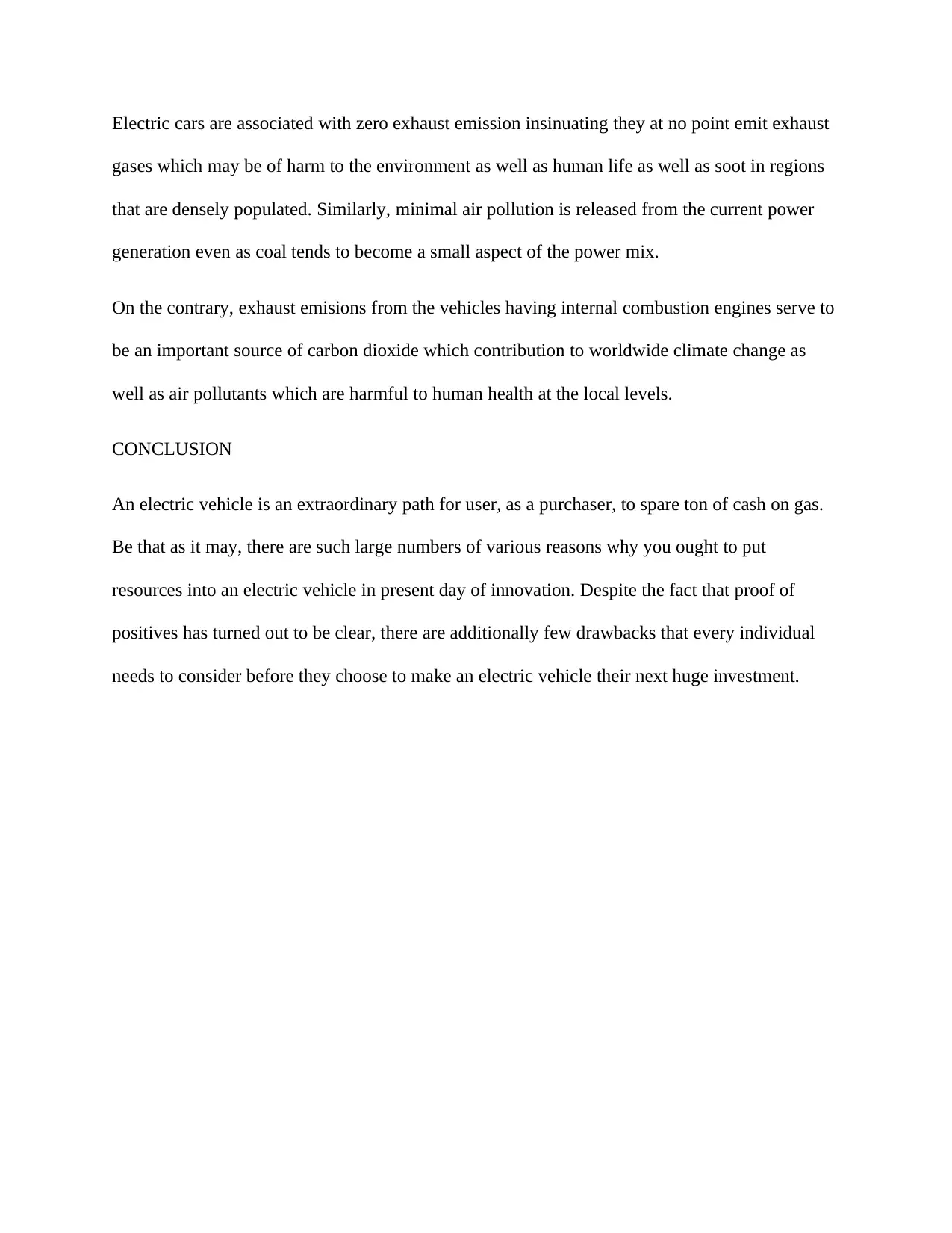
Electric cars are associated with zero exhaust emission insinuating they at no point emit exhaust
gases which may be of harm to the environment as well as human life as well as soot in regions
that are densely populated. Similarly, minimal air pollution is released from the current power
generation even as coal tends to become a small aspect of the power mix.
On the contrary, exhaust emisions from the vehicles having internal combustion engines serve to
be an important source of carbon dioxide which contribution to worldwide climate change as
well as air pollutants which are harmful to human health at the local levels.
CONCLUSION
An electric vehicle is an extraordinary path for user, as a purchaser, to spare ton of cash on gas.
Be that as it may, there are such large numbers of various reasons why you ought to put
resources into an electric vehicle in present day of innovation. Despite the fact that proof of
positives has turned out to be clear, there are additionally few drawbacks that every individual
needs to consider before they choose to make an electric vehicle their next huge investment.
gases which may be of harm to the environment as well as human life as well as soot in regions
that are densely populated. Similarly, minimal air pollution is released from the current power
generation even as coal tends to become a small aspect of the power mix.
On the contrary, exhaust emisions from the vehicles having internal combustion engines serve to
be an important source of carbon dioxide which contribution to worldwide climate change as
well as air pollutants which are harmful to human health at the local levels.
CONCLUSION
An electric vehicle is an extraordinary path for user, as a purchaser, to spare ton of cash on gas.
Be that as it may, there are such large numbers of various reasons why you ought to put
resources into an electric vehicle in present day of innovation. Despite the fact that proof of
positives has turned out to be clear, there are additionally few drawbacks that every individual
needs to consider before they choose to make an electric vehicle their next huge investment.

References
Valenzuela, A., Montalvo, I. and Barrera-Singaña, C., 2017, September. Electrical vehicle:
Facing future challenges in quito. In 2017 IEEE PES Innovative Smart Grid Technologies
Conference-Latin America (ISGT Latin America) (pp. 1-6). IEEE
Matthews, L., Lynes, J., Riemer, M., Del Matto, T. and Cloet, N., 2017. Do we have a car for
you? Encouraging the uptake of electric vehicles at point of sale. Energy Policy, 100, pp.79-88
Philipsen, R., Schmidt, T., Van Heek, J. and Ziefle, M., 2016. Fast-charging station here, please!
User criteria for electric vehicle fast-charging locations. Transportation research part F: traffic
psychology and behaviour, 40, pp.119-129
Taljegard, M., 2017. The impact of an Electrification of Road Transportation on the Electricity
system in Scandinavia(Doctoral dissertation, Department of Space, Earth and Environment,
Chalmers University of Technology)
Bobba, S., Mathieux, F., Ardente, F., Blengini, G.A., Cusenza, M.A., Podias, A. and Pfrang, A.,
2018. Life Cycle Assessment of repurposed electric vehicle batteries: an adapted method based
on modelling energy flows. Journal of Energy Storage, 19, pp.213-225
Yong, J.Y., Ramachandaramurthy, V.K., Tan, K.M. and Mithulananthan, N., 2015. A review on
the state-of-the-art technologies of electric vehicle, its impacts and prospects. Renewable and
Sustainable Energy Reviews, 49, pp.365-385
Heinberg, R. and Fridley, D., 2016. Renewable electricity: falling costs, variability, and scaling
challenges. In Our Renewable Future (pp. 47-80). Island Press, Washington, DC
Valenzuela, A., Montalvo, I. and Barrera-Singaña, C., 2017, September. Electrical vehicle:
Facing future challenges in quito. In 2017 IEEE PES Innovative Smart Grid Technologies
Conference-Latin America (ISGT Latin America) (pp. 1-6). IEEE
Matthews, L., Lynes, J., Riemer, M., Del Matto, T. and Cloet, N., 2017. Do we have a car for
you? Encouraging the uptake of electric vehicles at point of sale. Energy Policy, 100, pp.79-88
Philipsen, R., Schmidt, T., Van Heek, J. and Ziefle, M., 2016. Fast-charging station here, please!
User criteria for electric vehicle fast-charging locations. Transportation research part F: traffic
psychology and behaviour, 40, pp.119-129
Taljegard, M., 2017. The impact of an Electrification of Road Transportation on the Electricity
system in Scandinavia(Doctoral dissertation, Department of Space, Earth and Environment,
Chalmers University of Technology)
Bobba, S., Mathieux, F., Ardente, F., Blengini, G.A., Cusenza, M.A., Podias, A. and Pfrang, A.,
2018. Life Cycle Assessment of repurposed electric vehicle batteries: an adapted method based
on modelling energy flows. Journal of Energy Storage, 19, pp.213-225
Yong, J.Y., Ramachandaramurthy, V.K., Tan, K.M. and Mithulananthan, N., 2015. A review on
the state-of-the-art technologies of electric vehicle, its impacts and prospects. Renewable and
Sustainable Energy Reviews, 49, pp.365-385
Heinberg, R. and Fridley, D., 2016. Renewable electricity: falling costs, variability, and scaling
challenges. In Our Renewable Future (pp. 47-80). Island Press, Washington, DC
⊘ This is a preview!⊘
Do you want full access?
Subscribe today to unlock all pages.

Trusted by 1+ million students worldwide
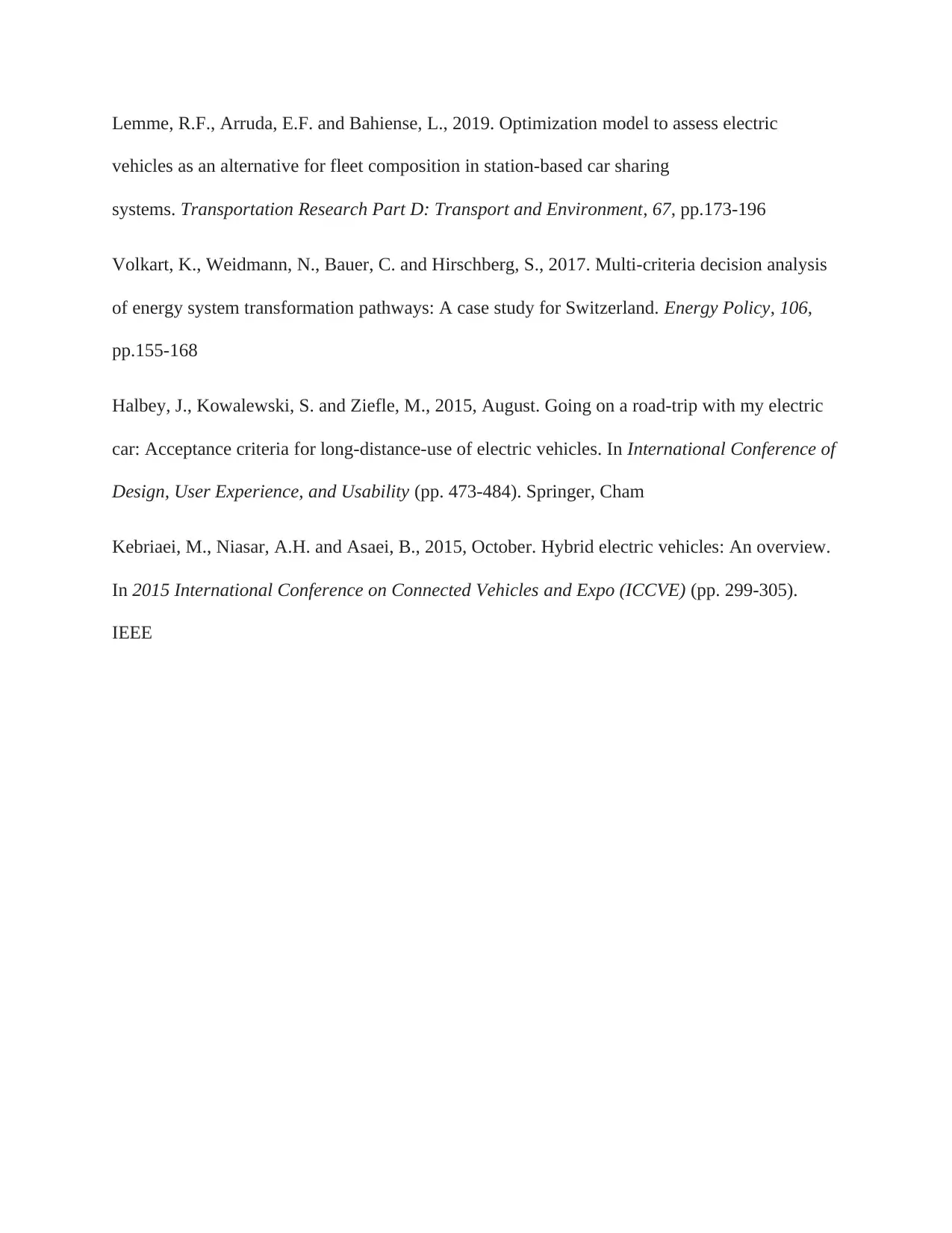
Lemme, R.F., Arruda, E.F. and Bahiense, L., 2019. Optimization model to assess electric
vehicles as an alternative for fleet composition in station-based car sharing
systems. Transportation Research Part D: Transport and Environment, 67, pp.173-196
Volkart, K., Weidmann, N., Bauer, C. and Hirschberg, S., 2017. Multi-criteria decision analysis
of energy system transformation pathways: A case study for Switzerland. Energy Policy, 106,
pp.155-168
Halbey, J., Kowalewski, S. and Ziefle, M., 2015, August. Going on a road-trip with my electric
car: Acceptance criteria for long-distance-use of electric vehicles. In International Conference of
Design, User Experience, and Usability (pp. 473-484). Springer, Cham
Kebriaei, M., Niasar, A.H. and Asaei, B., 2015, October. Hybrid electric vehicles: An overview.
In 2015 International Conference on Connected Vehicles and Expo (ICCVE) (pp. 299-305).
IEEE
vehicles as an alternative for fleet composition in station-based car sharing
systems. Transportation Research Part D: Transport and Environment, 67, pp.173-196
Volkart, K., Weidmann, N., Bauer, C. and Hirschberg, S., 2017. Multi-criteria decision analysis
of energy system transformation pathways: A case study for Switzerland. Energy Policy, 106,
pp.155-168
Halbey, J., Kowalewski, S. and Ziefle, M., 2015, August. Going on a road-trip with my electric
car: Acceptance criteria for long-distance-use of electric vehicles. In International Conference of
Design, User Experience, and Usability (pp. 473-484). Springer, Cham
Kebriaei, M., Niasar, A.H. and Asaei, B., 2015, October. Hybrid electric vehicles: An overview.
In 2015 International Conference on Connected Vehicles and Expo (ICCVE) (pp. 299-305).
IEEE
1 out of 10
Related Documents
Your All-in-One AI-Powered Toolkit for Academic Success.
+13062052269
info@desklib.com
Available 24*7 on WhatsApp / Email
![[object Object]](/_next/static/media/star-bottom.7253800d.svg)
Unlock your academic potential
Copyright © 2020–2025 A2Z Services. All Rights Reserved. Developed and managed by ZUCOL.





